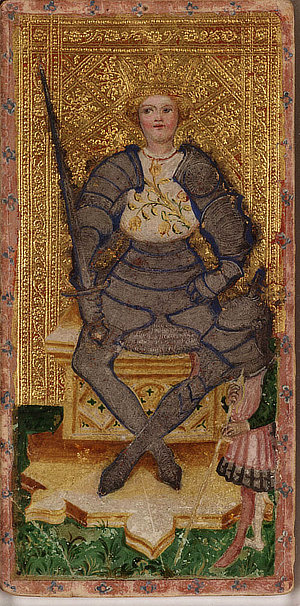Cary-Yale (Visconti di Modrone)
The “Visconti-Sforza” decks are a family of approximately 15 trionfi decks created in the 15th century, none of which retain a complete set of cards. They are believed to have been painted by Bonifacio Bembo or his family. Bembo was an Italian painter and miniaturist of the early-Renaissance period. The cards’ symbolism reflect his interest in neoplatonism. The decks are particularly admired for their beauty and the incorporation of precious materials. The cards often depict members of the Sforza and Visconti families.




The Visconti di Modrone deck, made in Milan, Italy, circa 1450, is possibly the oldest surviving example of such decks — some scholars argue that it is older than the Pierpont-Morgan Bergamo deck. It is also known as Cary-Yale (after the Cary Collection of Playing Cards donated by American collector Melbert B. Cary to the Yale University Library) and Filippo Maria Visconti Tarot (after the man who may have commissioned it). It is believed to have been produced to honor the tenth anniversary of the marriage of Filippo's daughter Bianca Maria Visconti to Francesco I Sforza, the fourth duke of Milan.






Uniquely among historical Western decks, it has six ranks of court cards. Besides the usual king, queen, knight and jack cards, there is a damsel (sometimes referred to as a “female page”) and a lady on horseback (sometimes referred to as a “female knight”). The gender balance and the horsewomen — features missing from the court cards of later standard decks — is well in keeping with the formidable character of Bianca Maria Visconti and of the Sforza family.
While still a young woman, Bianca Maria Visconti’s skills in state administration and diplomacy were widely chronicled. She was named regent of the Marche in 1442 when she was seventeen, the year after she married Francesco I Sforza, the fourth duke of Milan. Six years later, she won popular acclaim as “Warrior Woman” after she donned a suit of parade armor and hurried, along with some troops and the populace, to fight off a Venetian force attacking her dowry city of Cremona while Sforza was away. The battle lasted all day before Sforza returned to aid the beleagured city. Besides noteworthy military achievements, she was highly educated and in later years devoted herself to diplomacy, to restoration of ducal residences, and to public works including opening a large hospital as well as directly helping many poor women.
Also of note here are the Sforza tradition of humanist education for women and that the Sforzas, unlike most European nobility, promoted martial skills among their daughters. In a time when European women’s participation in the hunt itself, rather than mainly in the activities following the hunt, was only beginning to happen, Bianca Maria Visconti had grown up keen, like her father Filippo Maria Visconti, on horses and hunting — and Bianca's granddaughter, Caterina Sforza, learned with her brothers to use a sword, to ride horses and hunt. The Sforzas — whose adopted name means “force” — descended from a line of powerful military leaders, and they held that such skills fostered emotional self-mastery and courage in young children.
Besides the unusual court cards, another difference from standard decks is that the trump cards include three cards for the theological virtues (Faith, Hope and Charity) of Christian philosophy and theology; they appear only in this and Minchiate decks.



Some cards of this deck are lost to history, and the original number of cards in the deck is uncertain. The deck is in the keeping of the Beinecke Rare Book and Manuscript Library, Yale University.
For more information, see the following articles.
- Early Tarot Cards
- Wikipedia — Visconti-Sforz tarot deck — Cary-Yale
- Tarotpedia — Visconti-Sforz tarot
- Beinecke Library Yale — Visconti Tarot
- Dark Tarot — The Oldest Tarot Deck
- Tarot Wheel — The Visconti di Modrone Deck - 5 Suits Of 16 Cards
- Andy’s Playing Cards — The Tarot and other Early Cards — The Visconti Tarots
- Tarot Heritage — Tarocchi Visconti di Modrone (Cary-Yale) from Il Meneghello
See also the Pierpont-Morgan Bergamo (Visconti-Sforza) deck.
Note: The Visconti-Sforza decks influenced the structure and interpretation of later decks, including occult tarot decks. Early Italian trionfi decks were, like other playing cards, intended for gaming. (Filippo Maria Visconti was reportedly interested in card playing since youth.) Like other playing cards, they might have been used for divination at times but their interpretation would likely have been different in significant respects from later tarot.
However, for those who wish to look up corresponding Waite-Smith style card meanings, this Web site places the cards representing the theological virtues — Faith, Hope, Charity — where other decks have the Pope, the Star and the Papess; this order is not authoritative and is probably not the original order (if there was one), but follows a suggested (but question-marked) comparison in a table on page 45 of The Encyclopedia of Tarot, Volume II by Stuart R. Kaplan.